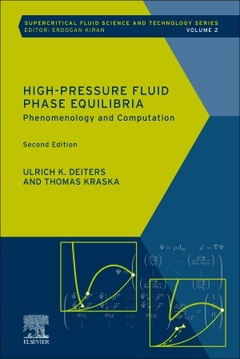High-Pressure Fluid Phase Equilibria (2nd Ed.) Phenomenology and Computation Supercritical Fluid Science and Technology Series
Auteurs : Deiters Ulrich K, Kraska Thomas

High pressures play a more and more important role in modern technology. Examples are the supercritical fluid extraction of medical drugs and dyes from biological material, the handling of compressed or liquefied gases (including natural gas or hydrogen), the operation of modern thermal power plants, and various technical processes for controlled particle formation. High-Pressure Fluid Phase Equilibria, Second Edition enables understanding of the complicated phase behavior that fluid or fluid mixtures (liquids, gases, or supercritical phases) can exhibit at elevated pressures. The underlying thermodynamic equations are explained, and robust algorithms for the computation of such equilibria (including solid?fluid equilibria) are proposed. Since the publication of the first edition of this book, there have been many new developments, for instance, differential equation methods for the computation of phase equilibria, accurate numerical differentiation, and high-precision equations of state (e.g., the GERG model). Moreover, more detail and explanation has been added on important topics that were only briefly examined in the original book to better assist the reader, such as expansion processes and chemical reactions). The book remains invaluable as a single resource for grasping the intricacies of fluid phase behavior. It enables the readers to write or improve their own computer programs for the calculation of phase equilibria. It will appeal to graduate students of chemical engineering and university research staff involved in chemical engineering of supercritical fluids or the physical chemistry of fluids; the book can also serve as the basis of lectures or advanced students? seminars.
- Introduction
- Phenomenology of phase diagrams
- Experimental observation of phase equilibria
- Thermodynamic variables and functions
- Stability and equilibrium
- Non-isothermal applications and chemically reactive systems
- Solid–fluid equilibrium
- Equations of state for pure fluids
- Equations of state for mixtures
- Global phase diagrams
- Algebraic and numeric methods
- Theorems and proofs
- Equations of state: auxiliary equations for programming
- Solutions of the problems
Ulrich Deiters was born in 1953. He studied chemistry at the Ruhr University of Bochum (Germany), where he, under the supervision of Gerhard M. Schneider, obtained his doctorate in physical chemistry in 1979. He then joined the groups of Keith E. Gubbins and William B. Streett at the Cornell University, Ithaca (USA). After his return to Bochum he founded his own research group. He served for many years as chairman of the IUPAC Subcomittee on Thermodynamic Data. In 1993 he became a professor of physical chemistry at the University of Cologne, from where he formally retired in 2018. His main research fields are the thermodynamics and statistical thermodynamics of fluid mixtures, Monte Carlo simulation, prediction of thermodynamic data ab initio from quantum mechanical calculations, and the development of mathematical methods for the prediction of phase diagrams.
Thomas Kraska was born in 1964. He studied chemistry at the Ruhr University of Bochum (Germany), where he, under the supervision of Ulrich K. Deiters, obtained his doctorate in physical chemistry in 1992. He then joined the group of Keith E. Gubbins at Cornell University, Ithaca (USA) for two years, followed by a research stay for 6 months in the group of Kenneth S. Pitzer at UC Berkeley (USA). He returned to Cologne University in Germany and founded his own research group. In 1999 he obtained his habilitation and continued in Cologne with research on molecular thermodynamics, MD simulation, and the nucleation and growth of metallic and pharmaceutical nanoparticles. At present he is active in the field of chemical education, fostering physical chemistry, mathematization, and molecular simulation in secondary chemistry education.
- Comprehensively presents the complex world of phase equilibria (binary and ternary) and the various methods for computing phase equilibria, whilst carefully considering the relevant pressure and temperature ranges
- Introduces phase diagram classes, how to recognize them, and how to identify their characteristic features
- Presents rational nomenclature of binary fluid phase diagrams
- Includes problems and solutions for self-testing, exercises, or seminars
- Presentation of the phase equilibria models is extended and expanded
- There are now more descriptions on more equations of state, especially the PCSAFT EoS
- Features new chapter on nonisothermal applications and chemically reactive systems and extensive updates and additions to all existing chapters
Date de parution : 12-2023
Ouvrage de 474 p.
15.2x22.8 cm
Thèmes de High-Pressure Fluid Phase Equilibria :
Mots-clés :
Thermodynamics; fluid mixtures; supercritical fluids; algorithms; numerical methods; programming; phase diagrams; vapor–liquid equilibria; liquid–liquid equilibria; solid–fluid equilibria; high pressure; phase behaviour; azeotropy; critical loci; phase diagram classes; equations of state



